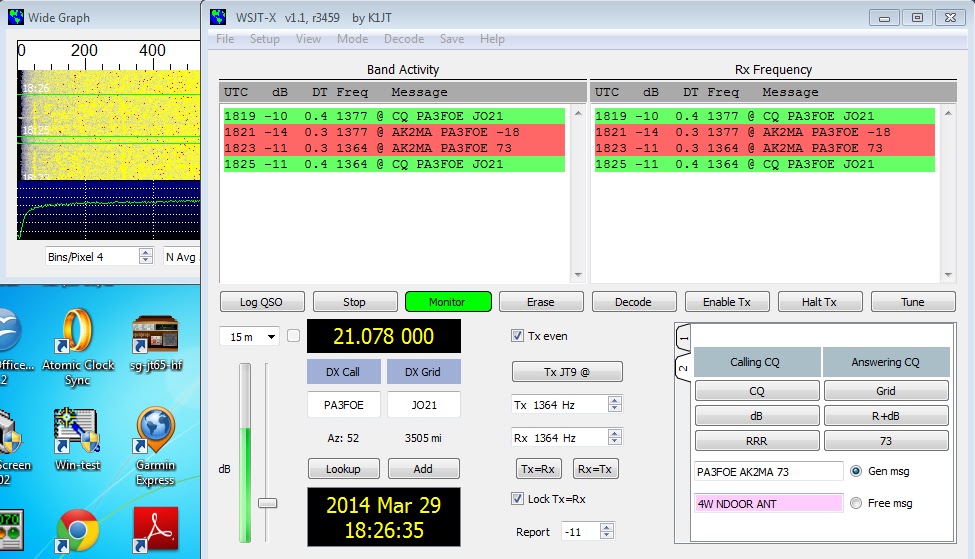 |
| First JT9 QSO |
KL8DX was my callsign while active in Alaska near Denali National Park. Traded that for AK2MA when we arrived in Massachusetts. It continues to follow me as we travel down our winding road of life, now operating from Oregon.
Saturday, March 29, 2014
JT9 Transmitted & Received
Labels:
Buddipole,
Ham Radio Deluxe,
Icom IC-703PLUS,
JT9,
PA3FOE
Tuesday, March 25, 2014
JT9, My Next Experimental Mode
 |
| First JT9 Decodes by AK2MA |
I decided to just monitor 40 meters tonight to see what I can hear. I probably won't attempt my first QSO with this mode until the weekend but I wanted to start getting familiar with it. The download was quick and the install was very easy. The program was decoding once I got the initial set-up completed (selecting the com port along with adding my callsign and grid square).
 |
| Hamspots JT9 & JT65 Spots with my first DX spot - G3VGZ |
I recently ordered a refurbished laptop which I plan on using as my main ham computer. Once it arrives, my desktop will be retired and the laptop will be my casual operating & contest computer. Since I won't have a dedicated hamshack for several more years, it's time I consolidate and downsize.
Sunday, March 23, 2014
Bouncing Around the Globe, QRP Style.
 |
| TV Tray Set-up |
 |
| Close but No Cigar |
 |
| QRP 3 Watts |
 |
| AK2MA Table Top DX Station |
 |
| DK2HX Indoor antenna to indoor antenna |
Sunday, March 16, 2014
Understanding My Propagation and Work'n a Few QRP
 |
| PSK Reporter Map for AK2MA |
 |
| Alaska |
 |
| Japan |
 |
| JT65A & 15 Meters on Sunday, March 16th, 2014 |
 |
| Indoor Buddipole Setup |
For now, this is my station but I'm thankful to be able to get on the air. I'm not sure when and if I will ever have a full station with exterior hardware on the air but as hams have proven over the years, where there is a will, there is a way. In the mean time, I'll continue to surf the propagational wave of DX in hopes of landing that next new one bringing me closer to that very meaningful certificate I hope to collect. Just like the lottery, you can't win unless you play.
Labels:
Buddipole,
DXCC,
IC-703Plus,
JT65,
KL2R,
NW7US,
Propagation,
PSK Reporter,
QRP
Sunday, March 2, 2014
JT65A
 |
| JT65A QSO |
It took me a bit to figure out how to dial down the ALC and Mic Gain to near nothing on the Icom IC-703+. I have them both at their lowest settings so now I just need to get on, see what reports I get and then look at Hamspots to see who is hearing me and how strong. That's the great thing about modern technology, you can check sites like Reverse Beacon Network (RBN) when running CW or Hamspots when running digital and it gives you a great summary of how well your signal is being heard hundreds and even thousands of miles away.
Saturday, March 1, 2014
Interface Cable Located! Now the Fun Begins.
 |
| First Night of PSK31 on Indoor Buddipole & IC703+ |
It just so happens that I carry my Icom IC-703+ and related equipment in a small, deep plastic pistol case. A cheap Walmart knockoff of the Pelican cases made by Plano. I checked my case a few times with no success. I decided to pull everything out of it today and whaa-laa! I found it in the very bottom of the case underneath the foam padding. I figured I had it close but I was just not looking in the right place.
I got everything hooked up and decided to run a bit of JT65, however my clock was always off by more than 8 seconds! Normally such issues were caused when I would utilize Google Chrome or browsed in the background. Since this timing issue was normally indicative of browser use, I closed down everything except JT65 and of course, Dimension4, for the clock sync. Still it would always be 8 seconds off so needless to say, I was not decoding anything. I had it working just fine in Alaska, so something had to of changed. I decided to run PSK31 instead.
I had my Buddipole tuned for 10 meters but I parked on 20 meters in receive only mode for PSK31. I was using HRD's DM780 to decode and upload the spots or my reception reports. The map above is what I was hearing on 20 meters today on my indoor antenna.
I had posted a tweet regarding my clock issues and thankfully Karen, W4KRN reminded me that the program needed to be run as an Administrator in Windows 7. Sometime during one of my numerous Windows updates (I normally shut off updates on ham computers as updates lead to more hair pulling and heartburn than what they are worth) something must have changed. I checked and sure enough, it was not running as Administrator so once I checked that box, things were back to where they were before I departed the 49th.
 |
| IC703+ Connected to Mini Dell running DM780 |
Labels:
Buddipole,
Dimension4,
DM780,
HRD,
IC-703Plus,
JT65,
PSK31,
QRP,
W4KRN,
WSPR
Subscribe to:
Posts (Atom)